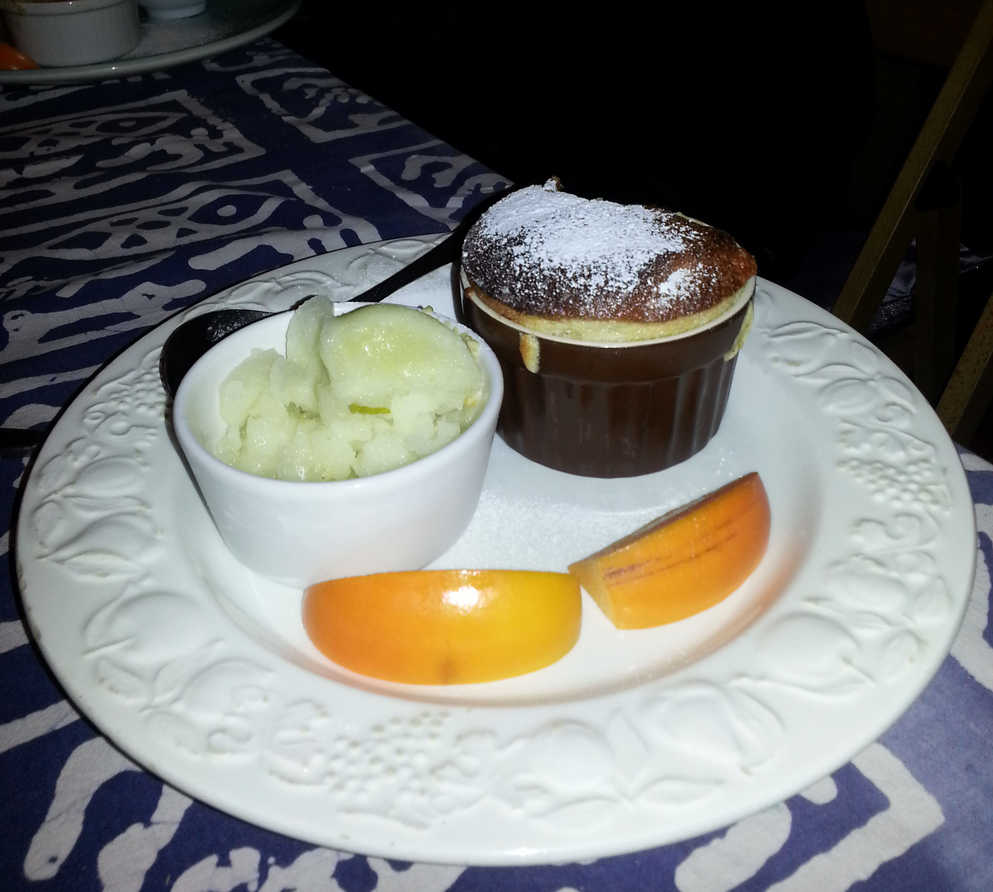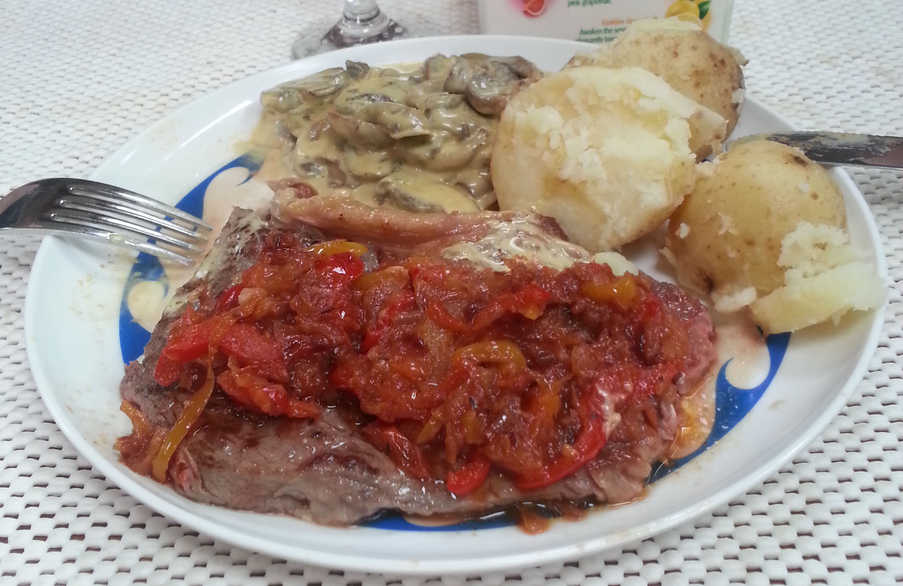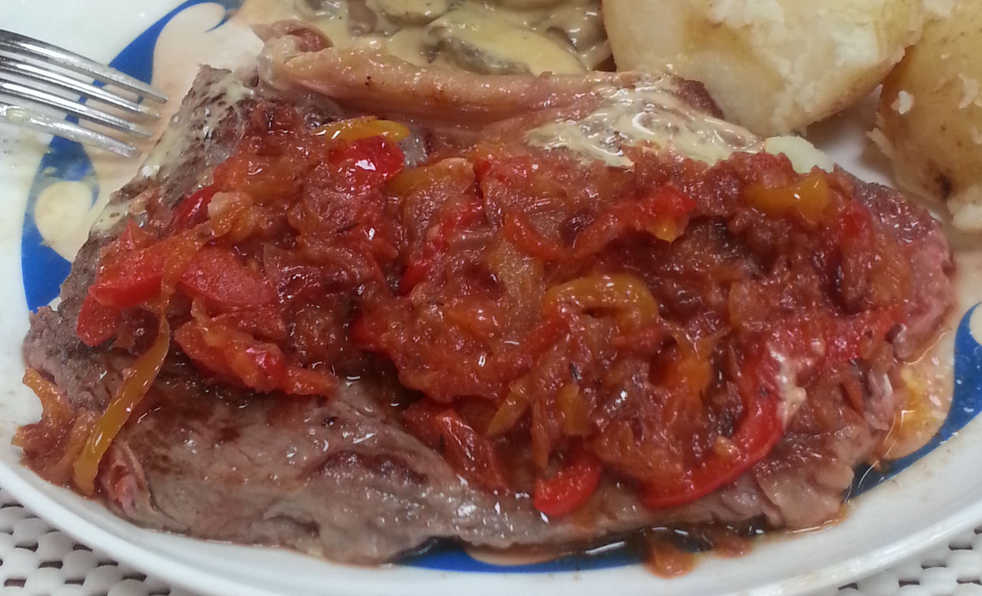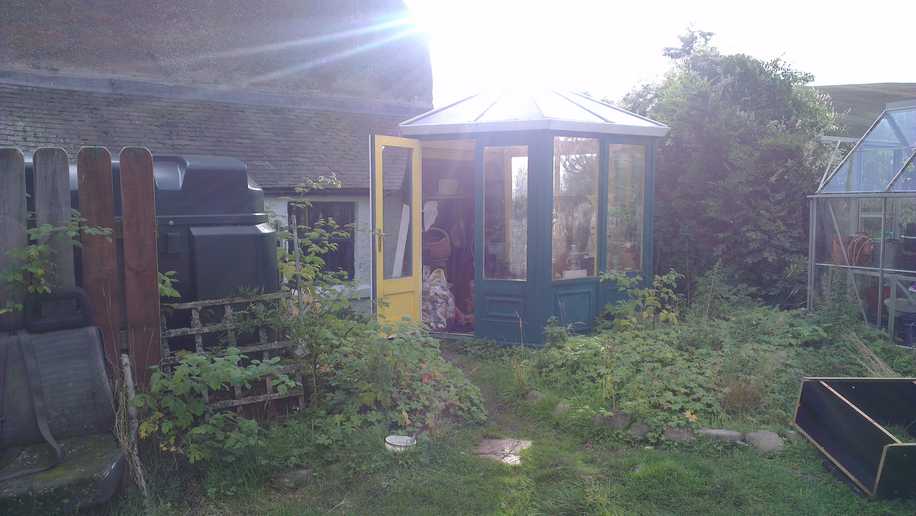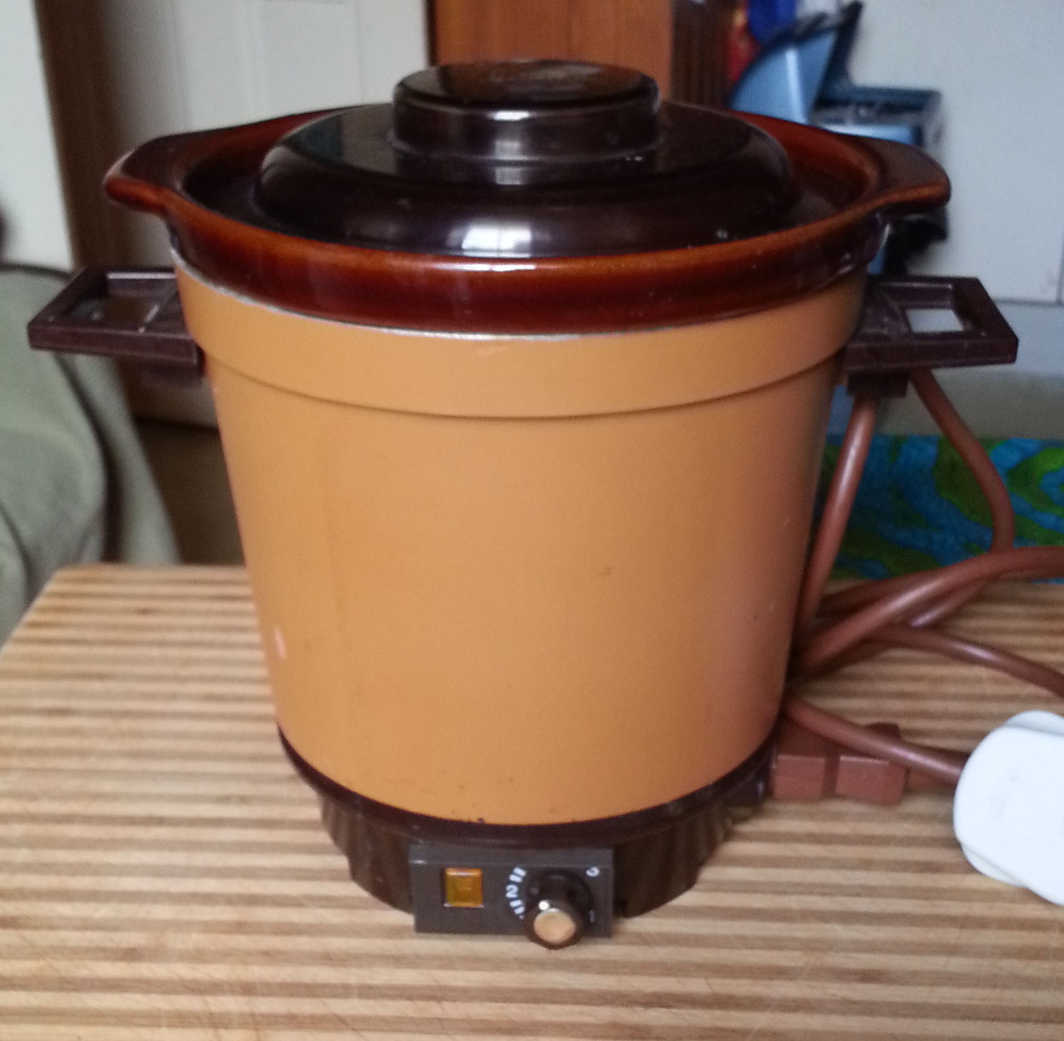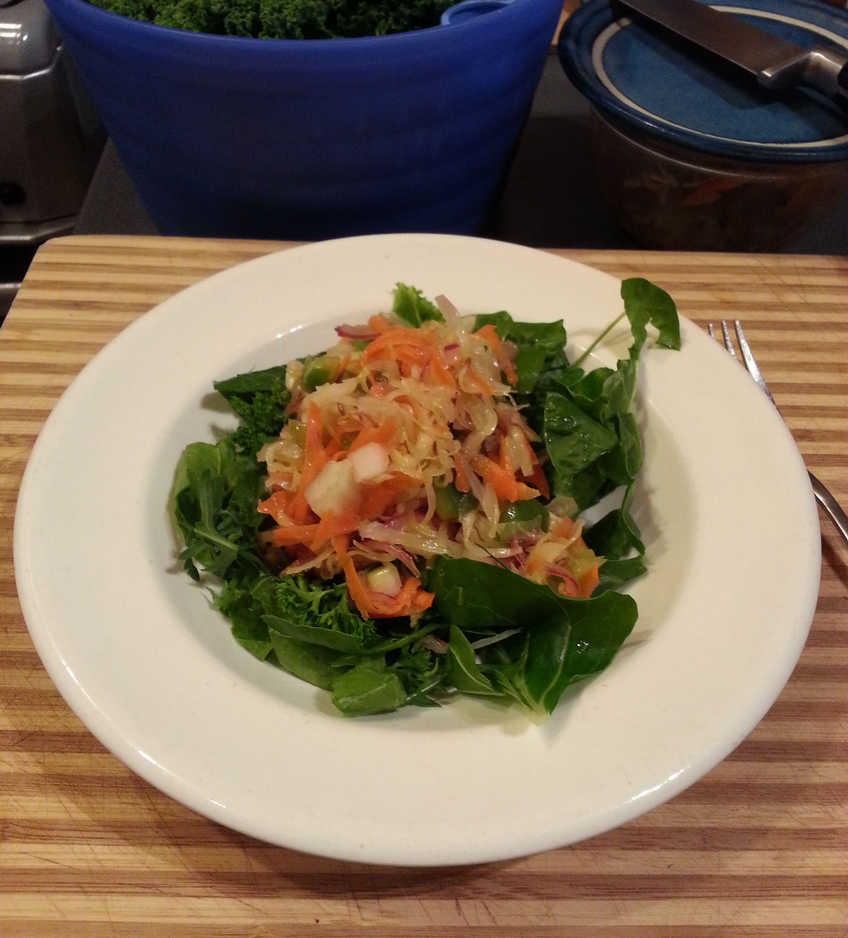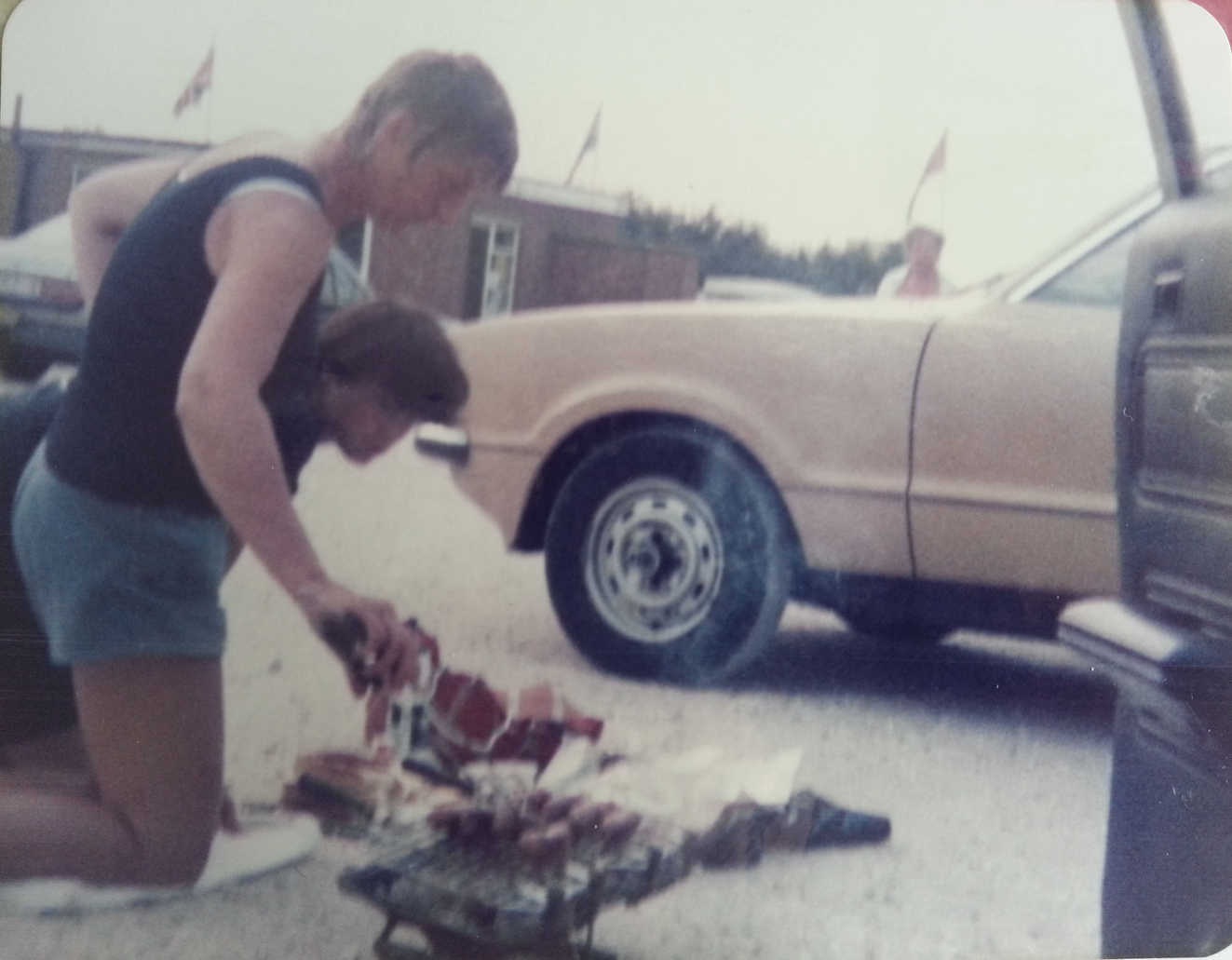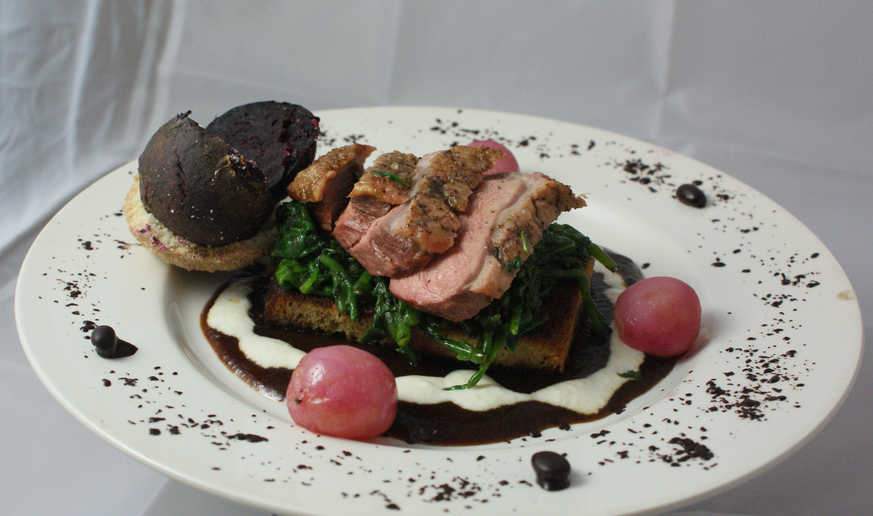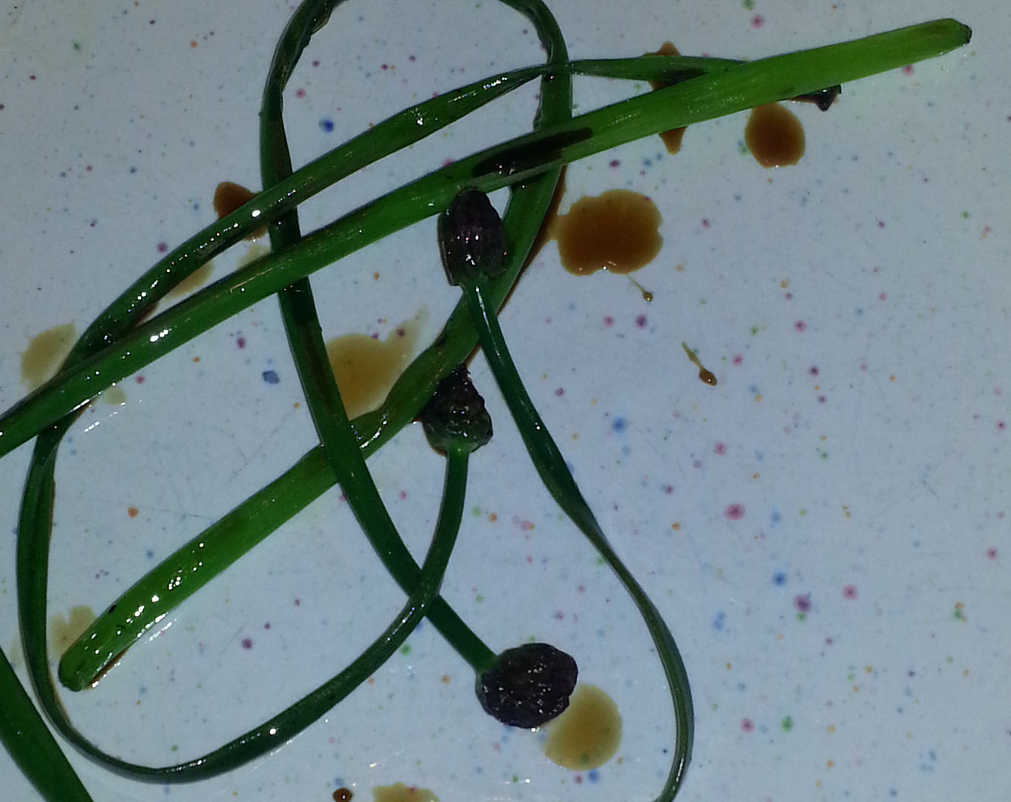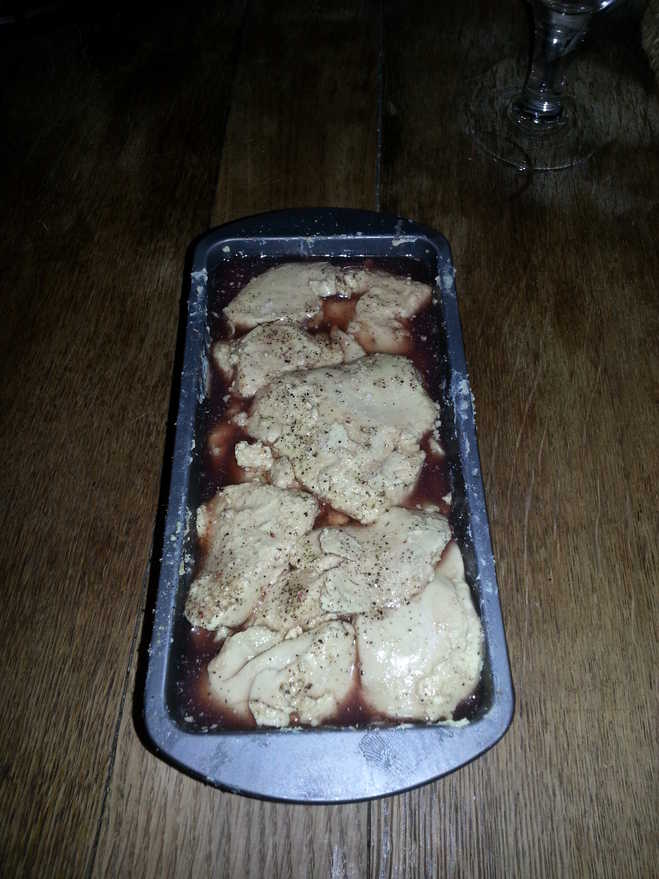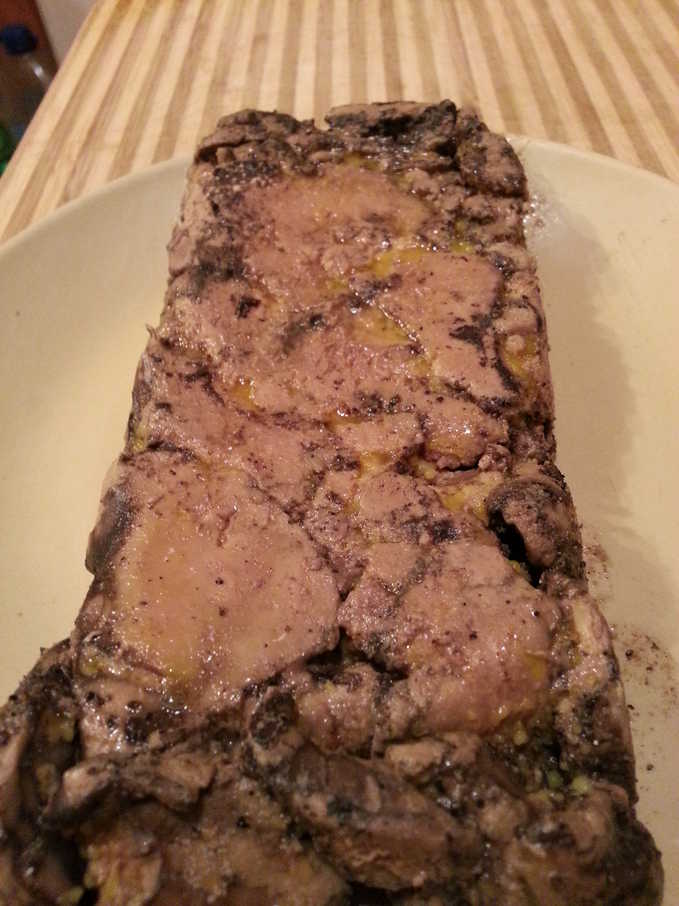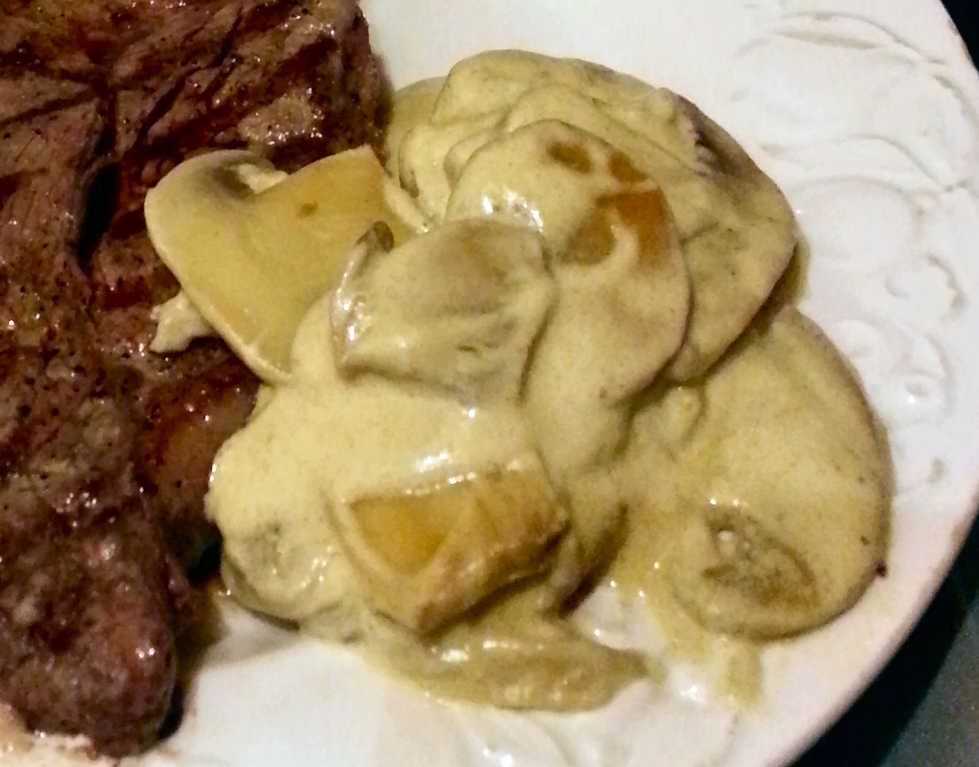
Pumpkins Forever!

So many pumpkins, so little time. To eat them before they rot apart and stink my flat out.
After Pumpkin Palooza it took me 6 days to do all the washing up, and another 4 days to finish eating all the cooked leftovers. It's been just like Christmas!
I cooked up quite a few of my spare ingredients into a surprisingly unappetising
Tomato, Beans, Feta, Black Olive and Feta Bake,
which I then froze. So I'll probably never finish that!
I managed to stuff a pumpkin with most of the rest of the vegetables, which just leaves a fridge-full of bloody marys, another dish of cooked borlotti beans, those bloody egg yolks and a score of pumpkins...
Does a dish really count as leftovers if you have to buy more ingredients to make it? Well, when answering the question what to do with almost a dozen leftover egg yolks? I bought a pack of bacon and some leeks to make a quiche - so a partially leftover supper then. I also came this close to buying some pre-prepared shortcrust pastry from the local Fucking Supermarket™ too but then I came to my senses. It takes about 5 minutes to make a batch of shortcrust pastry, people, and maybe 5 minutes to wash up, plus you get to experiment with slightly different variations each time as part of your evolutionary strategy for developing that perfect crust. (You do faithfully record all those failures along the way right?) Look it's only a short step from ready-made shortcrust pastry to the sellout madness of Delia which can only end with the buying of bags of frozen mashed potatoes and tins of mince. So just don't.
In the interests of transparency, though, I should confess I've been known to buy ready-made puff pastry. And jars of mayonnaise.
The shame!
Two weeks later and I've finally used up the last non-pumpkin leftover in a much more satisfactory borlotti bean stew. Something along the lines of Mum's fabulous fasolia but with bacon. And chorizo. And feta cheese.
Only 16 pumpkins to go...
I managed to stuff a pumpkin with most of the rest of the vegetables, which just leaves a fridge-full of bloody marys, another dish of cooked borlotti beans, those bloody egg yolks and a score of pumpkins...
Does a dish really count as leftovers if you have to buy more ingredients to make it? Well, when answering the question what to do with almost a dozen leftover egg yolks? I bought a pack of bacon and some leeks to make a quiche - so a partially leftover supper then. I also came this close to buying some pre-prepared shortcrust pastry from the local Fucking Supermarket™ too but then I came to my senses. It takes about 5 minutes to make a batch of shortcrust pastry, people, and maybe 5 minutes to wash up, plus you get to experiment with slightly different variations each time as part of your evolutionary strategy for developing that perfect crust. (You do faithfully record all those failures along the way right?) Look it's only a short step from ready-made shortcrust pastry to the sellout madness of Delia which can only end with the buying of bags of frozen mashed potatoes and tins of mince. So just don't.
In the interests of transparency, though, I should confess I've been known to buy ready-made puff pastry. And jars of mayonnaise.
The shame!
Two weeks later and I've finally used up the last non-pumpkin leftover in a much more satisfactory borlotti bean stew. Something along the lines of Mum's fabulous fasolia but with bacon. And chorizo. And feta cheese.
Only 16 pumpkins to go...
Comments (0)
Bonfire of the Pumpkins

Remember, remember, the fifth of November. Pumpkins and butternut squashAline my cute landlady and Flora my cute sailing buddy were good enough to help out with road testing some elements of my upcoming Pumpkin Palooza dinner party.
To which neither were invited - sorry girls!
I had a couple of soups to try, along with a likely-looking pumpkin-pie alternative: a pumpkin soufflé! I found the soufflé recipe online, along with a suggested serving of bourbon and molasses sauce which I decided to body-swerve, plumping for another round of my leftover mango sorbet instead. That will be positively its last outing, Flora, honest!
So two deliberately un-Thai-style soups were on the table I often find my pumpkin soups slipping inexorably into a resemblance of Thai green curry - a vegetarian Cannellini and Kale Soup (now with added pumpkin) or a chunky and very un-vegetarian Salt Cod, Chickpea and Chorizo Soup (also with pumpkin).
They were both excellent, to be honest, but I decided to go with the fishy, meaty one for the main event - it seemed more autumnal, slightly more substantial, plus it looked really good and I wasn't feeding any pesky tarians.
And so down to my local Fucking Supermarket™ to buy a cheap chicken to make stock with, noticing as I did so the outrageous price of ready-made fresh stock. To get more than a litre of stock it's actually cheaper to buy a chicken, plus then you also have a chicken-load of cheap, watery, hormone-laden chicken to eat up.
Hmmm, actually buying that stock is starting to look more attractive...
Cannellini, Kale and Pumpkin Soup
soup veg vegan
The puréed beans give this soup a very creamy texture and my pumpkin addition makes it a bright orange colour - perfect for Autumn.
Although this was quite a tasty soup I wasn't over-impressed with the kale, though I'm often not. It seemed a bit on the tough and tasteless side
and it rapidly turns an unappetising brown colour making it less attractive after reheating. I found my salting approach helped with this.
I had to use ordinary kale, but I've subsequently found that Sainsbury's stock Cavolo Nero (aka Tuscan Kale) which I'd like to try instead - it might be an improvement.
I had to use ordinary kale, but I've subsequently found that Sainsbury's stock Cavolo Nero (aka Tuscan Kale) which I'd like to try instead - it might be an improvement.
I'm happy to report that it is better with the Cavolo Nero - it has much more flavour than our northern kale.
It does tend to be more stalk than leaf though, so only remove the thickest, woodiest stems or you'll have no cabbage left!
Serves 6
Ingredients
- 2 onions, chopped
- 1 medium carrot, chopped
- olive oil
- Coarse salt and freshly ground pepper
- 4 garlic cloves, minced, plus 2 garlic cloves, thinly sliced
- 1 tablespoon chopped fresh thyme
- Scant 1/4 teaspoon crushed red-pepper flakes
- 1-2 teaspoons fennel seeds
- 340g/12 oz cannellini beans (2 cups), picked through and soaked overnight
- 1 small pumpkin, de-seeded, roasted optional
- 6 cups water or vegetable stock
- 3 dried bay leaf
- 8 ounces Tuscan kale (lacinato kale/cavolo nero), stems and centre ribs removed, leaves sliced crosswise 1/2 inch thick
Grind the fennel seeds and the red pepper with a teaspoon of salt to powder.
Thoroughly wash the kale, cut away the stalks (you can use them like the bay leaves to add flavour while cooking the beans if you like) and slice cross-ways about 1cm wide.
Heat a couple of tablespoons oil in a medium Dutch oven or a large pot over medium heat. Cook onions and carrot until just softened, about 5 minutes. Season with the ground spices and fry. Stir in the minced garlic and thyme. Cook for 1 minute.
Drain and rinse cannellini beans. Add to Dutch oven with stock or water and bay leaves. Bring to a boil. Reduce heat to low. Simmer, covered, until beans are tender, about 45 minutes. Let cool slightly. Discard bay leaves.
Cut the pumpkin in half, scrape out the insides and set aside the cleaned seeds for roasting. Lay cut side down on a lightly oiled oven tray and roast at Gas Mark 5 for 20-30 minutes until softened and the skin starts to separate from the flesh. Peel and cut into chunks and add to the pot.
Working in batches, purée soup in a blender until smooth, transferring it to a clean pot as you work.
Bring the soup to a simmer. Stir in the kale and 1/4 teaspoon pepper. Simmer until the kale is tender, about 15 minutes. Season.
Meanwhile, heat 2 tablespoons oil in a small skillet over medium-low heat. Cook sliced garlic, stirring often, until crisp and golden, 1 to 2 minutes. Transfer garlic to a plate using a slotted spoon. Reserve garlic oil.
Divide soup among 6 bowls. Garnish with garlic chips, and drizzle with garlic oil.
Thoroughly wash the kale, cut away the stalks (you can use them like the bay leaves to add flavour while cooking the beans if you like) and slice cross-ways about 1cm wide.
It helps to break down the kale a little if you mix in a teaspoon of salt (don't overdo it) after slicing
and leave the salt to work it's magic while you prepare the soup.
Heat a couple of tablespoons oil in a medium Dutch oven or a large pot over medium heat. Cook onions and carrot until just softened, about 5 minutes. Season with the ground spices and fry. Stir in the minced garlic and thyme. Cook for 1 minute.
Drain and rinse cannellini beans. Add to Dutch oven with stock or water and bay leaves. Bring to a boil. Reduce heat to low. Simmer, covered, until beans are tender, about 45 minutes. Let cool slightly. Discard bay leaves.
Cut the pumpkin in half, scrape out the insides and set aside the cleaned seeds for roasting. Lay cut side down on a lightly oiled oven tray and roast at Gas Mark 5 for 20-30 minutes until softened and the skin starts to separate from the flesh. Peel and cut into chunks and add to the pot.
Working in batches, purée soup in a blender until smooth, transferring it to a clean pot as you work.
Bring the soup to a simmer. Stir in the kale and 1/4 teaspoon pepper. Simmer until the kale is tender, about 15 minutes. Season.
Meanwhile, heat 2 tablespoons oil in a small skillet over medium-low heat. Cook sliced garlic, stirring often, until crisp and golden, 1 to 2 minutes. Transfer garlic to a plate using a slotted spoon. Reserve garlic oil.
Divide soup among 6 bowls. Garnish with garlic chips, and drizzle with garlic oil.
Really nice, though it's definitely improved by resting before serving -
I find the kale can be rather tasteless until it is thoroughly wilted into the soup.
Don't leave it too long though - the kale can turn quite brown after a while.
I thought that for that special meal you could bake the puréed soup and the kale in a hollowed-out pumpkin in the oven.
Don't leave it too long though - the kale can turn quite brown after a while.
I thought that for that special meal you could bake the puréed soup and the kale in a hollowed-out pumpkin in the oven.
Pumpkin Soufflé
dessert veg
The online recipe calls for baking the soufflés at Gas 6, but I found they were starting to burn at that temperature -
Gas 5 worked better for me.
Also as online commenters have mentioned you could easily increase the quantity of pumpkin to 1 cup and reduce the eggs to 8 -
I did have plenty of leftover,
plus it might make them less meringuey.
I skipped the advertised Bourbon-Molasses sauce (which sounded a bit sickly and anyway I preferred the idea of Bourbon-Maple) and went for a refreshing sorbet instead.
I skipped the advertised Bourbon-Molasses sauce (which sounded a bit sickly and anyway I preferred the idea of Bourbon-Maple) and went for a refreshing sorbet instead.
- The pumpkin mixture (without egg whites) can be made 1 day ahead and chilled.
- Soufflés can be assembled 1 hour before baking and kept in freezer. And apparently bake just as well from frozen - which is a surprise!
- Baked soufflés can be re-puffed if necessary in a 200°C/400°F oven 10 to 12 minutes (serve quickly, as they will deflate a little faster the second time around).
Makes 8
Ingredients
- ½ cup whole milk
- 1 tablespoon cornstarch
- ¼ teaspoon grated nutmeg
- ¼ teaspoon ground cinnamon
- ⅛ teaspoon ground allspice
- Pinch of ground cloves
- ¾ cup plus 1 tablespoon granulated sugar, divided, plus additional for coating ramekins
- ¾ cup puréed pumpkin
- 10 large egg whites You could use the leftover yolks to make a quiche!
- ¼ teaspoon salt
Equipment:- 8 x 6oz ramekins
Decoration:- icing sugar
Purée your pumpkin - Just halve a small pumpkin, scoop out the innards and bake at Gas Mark 5 for 20-30 minutes until the insides are soft.
I find a potato ricer is really handy for mashing the flesh - leave out any stringy bits.
Whisk together milk, cornstarch, spices, and 1 tablespoon granulated sugar in a small heavy saucepan. Bring to a boil over medium heat, whisking, then simmer, whisking, 2 minutes.
Remove from heat and whisk in pumpkin. Transfer to a large bowl and cool to room temperature.
Preheat oven to Gas Mark 6/200°C/400°F with rack in lower third. Butter 8 6oz ramekins and coat with granulated sugar, knocking out excess, then put in a large shallow baking pan.
Beat egg whites with salt in another large bowl using an electric mixer until they hold soft peaks. Add remaining ¾ cup granulated sugar a little at a time, beating, then beat until whites hold stiff, glossy peaks, 1 to 2 minutes more.
Fold one third of whites into cooled pumpkin mixture to lighten, then fold in remaining whites gently but thoroughly. Divide mixture among ramekins, mounding it. Sprinkle their tops with a little extra sugar to give them a bit of a crispy glaze.
Bake soufflés until puffed and golden, 18 to 20 minutes. Dust with confectioners sugar and serve immediately.
Whisk together milk, cornstarch, spices, and 1 tablespoon granulated sugar in a small heavy saucepan. Bring to a boil over medium heat, whisking, then simmer, whisking, 2 minutes.
Remove from heat and whisk in pumpkin. Transfer to a large bowl and cool to room temperature.
Preheat oven to Gas Mark 6/200°C/400°F with rack in lower third. Butter 8 6oz ramekins and coat with granulated sugar, knocking out excess, then put in a large shallow baking pan.
Beat egg whites with salt in another large bowl using an electric mixer until they hold soft peaks. Add remaining ¾ cup granulated sugar a little at a time, beating, then beat until whites hold stiff, glossy peaks, 1 to 2 minutes more.
Fold one third of whites into cooled pumpkin mixture to lighten, then fold in remaining whites gently but thoroughly. Divide mixture among ramekins, mounding it. Sprinkle their tops with a little extra sugar to give them a bit of a crispy glaze.
Bake soufflés until puffed and golden, 18 to 20 minutes. Dust with confectioners sugar and serve immediately.
Not too bad - they certain rise enthusiastically enough, and the recipe is pretty bullet-proof,
even when your egg whites refuse to whip up properly.
The only trouble is that due to the lack of wheat flour the mixture is a little bit meringue-like rather than cakey
and the tops are a bit leathery (hence the sprinkling of sugar prior to baking).
They went very nicely with a ginger-lime sorbet all the same.
They went very nicely with a ginger-lime sorbet all the same.
Fuck You BBC!

Alright, enough is enough.
I've been an ardent Radio 4 listener since I was a child when every day our entire family would sit down to dinner with the Archers. (How did Mum do that?)
Since then, however, we've seen the gradual implosion of a once-great institution. We've endured its endlessly bloating bureaucracy, its constant fawning to fame, it's craven pusillanimity before power, all overseen by an increasingly ineffectual leadership who nevertheless reward themselves and their cronies with ludicrous payoffs, their incomprehensible infatuation with Apple products at the expense of any support for open-source standards or Android services, not to mention the constant battle with their incompetent "A thousand clicks to get to listen to anything" website.
I can take a joke as well as the next man, and sniggered along with the rest of the country at their choice of a cross-dressing potter to present this year's hallowed Reith Lectures, though I do find it hard to take the unremittingly sycophantic Sue Lawley spending the first five minutes of each lecture breathlessly rhapsodising the Reith Clown's frock and choice of eyeshadow.
As an ardent feminist myself I have borne the slavishly politically correct, but painfully unfunny feminist comedy (apparently a contradiction in terms) whinings of Bridget Christie with equanimity. Episode no longer available online - thank Christ!
I've accepted the gradual deterioration of the flagship Today programme into a sound-bite-generating slanging match, conducted not so much as to inform the listener or present honestly the opinion of the interviewees, but solely in the interests of scoring a controversial headline.
I've put up with BBC reporting being increasingly prostituted as a blatant mouthpiece for manufactured outrage and PR agents' product placement and the sad decline of Radio 4's current affairs programme PM into a pathetic talk radio show featuring comic routines more appropriate to a Radio 1 DJ's posse than any collection of self-respecting journalists.
But finally we come to what might just prove to be the defining current event of our time - a story of world-shattering impact, a story that may well decide the legitimacy of our secret services, the trust we place in our Governments, the regard we hold for American values, and the future of our communications infrastructure: Edward Snowden's astonishing revelations of the NSA's inveterate spying and data capture program that appears determined to record and retain every on-line action conducted by every single person on this planet.
Forever.
And yet, from the BBC - barely a whisper. Hardly a mention. Not a story.
For me the line in the sand is drawn where our supine national broadcaster, acting as a slavish propagandist for a corrupt political class, actively promotes their dishonest and self-serving position that any amount of spying, prying, or monitoring of their own citizens is simply not to be questioned. That any discussion of it, any reporting of it can only serve to encourage terrorists, rapists and murderers. A public information service which instead conspires to censor the news and suppress discourse.
Listening to news item after item in which the BBC consistently seeks to deflect attention away from Snowden's revelations concerning GCHQ's immoral and illegal practices, and instead makes every attempt to collaborate in covering them up makes me sick to my stomach.
I gritted my teeth through last Friday's stuffing of their Any Questions panel with establishment lapdogs to nod away the inevitable Snowden question, but then in the supposed community response programme Any Answers to simply pretend that the question of the NSA and GCHQ's disgusting betrayal of public trust by engaging in wholesale spying on each and every one of us just never came up. Never happened. Nothing to see here. Is just fucking unacceptable.
The final straw, then, came this morning with the Today programme's blanket refusal to address any of the issues surrounding a French complaint to the U.S. condemning their mass surveillance of a supposed ally by simply passing off the entire affair as a diversionary political ploy by President Hollande [02:45 in].
Fuck You BBC.
Call yourself a news organisation? You're a fucking disgrace.
You can take your constant stream of threatening, intimidatory demands for monies for watching the TV I don't have and shove them up your arse.
PittenMouth. Again.

Another trip to Eyemouth that ended up in Pittenweem.
Seems to be something of a habit!
So once again we missed out on a nice dinner at the Churches Hotel, but we did get a decent fish supper from the Pittenweem fish shop. And to the naked chick who flashed me from that upstairs window - if you're really about 14, I'm sorry I looked. Otherwise I'll see you next year!
Due to tidal considerations we had to leave port at the crack of dawn, so we got a very nice sunrise over the Isle of May, and later a very nice steak lunch on the way back upriver.
Hmmmm. Steak.
Mind you, I think I'm figuring out why Scottish steak has always proved so very disappointingly inferior to American steaks.
It's because they're always so bloody thin! What's wrong with you people? Some of the best cow meat in the world and you slice it like you were re-soling flip-flops. I mean, I know that you Scots have a racial tendency to frugality, but the place is covered in cow meat. Cut it like you mean it for God's sake!
Having said that, the lardy effect of bucket-loads of American grain feed might also have something to do with it, pumping in all that delicious fatty marbling. Particularly as we Brits are now mortally afraid of hanging our lean meats to improve their flavour, preferring instead to wrap them in plastic as soon as possible.
Hmmmm. Plastic.
To cook up your very nice steak lunch, first get the steaks out of the fridge in plenty of time to bring them up to cabin temperature, then rub them with a pinch or two each of salt and leave to rest.
Chop the onions and start them caramelising for your peperonata, then lightly scrub some potatoes, quarter them as necessary, and set them to boil in heavily salted water in a pressure cooker.
Slice your mushrooms and get them sweating up for a nice mustard mushroom sauce, then begin heating up a dry frying pan as hot as you're skipper will let you to fry the steaks in. Pat the steaks dry and clean of salt, then rub them with pepper and olive oil.
When the potatoes come to the boil, put on the pressure lid and cook them for 10-15 minutes, while you fry the steaks for 1 minute per side, plus a minute for every centimetre of thickness. So twenty seconds per side for a good Scottish steak then. Don't overfill the pan.
Wipe the pan clean between batches so as to avoid asphyxiating the entire crew with the acrid burning smoke.
Set the steaks aside in tin foil to rest while you finish off the sauces and the potatoes.
Job Done.
Mustard Mushroom Sauce
sauce veg
Quite a nice simple sauce - though crème fraîche might be a good alternative to the cream,
and you could add a dash of sherry to the mushrooms too, if you had any aboard.
Serves 4
Ingredients
- 8 oz mushrooms, sliced
- 1 garlic clove, minced optional
- 2 tablespoons butter
- 1-2 teaspoons Dijon mustard
- a few tablespoons cream
- 2 egg yolks optional
Clean the mushrooms, and slice them into the thickness of 2 pound coins.
Sweat them gently in the butter with garlic and thyme,if you have any until their juice is drawn out, then stir through the mustard and add a generous amount of cream.
Simmer gently until the sauce thickens.
Season and serve.
If you like you can beat two egg yolks with a little cream and use these to thicken the sauce more. Don't overheat though, or you'll have Mustard Mushroom Scrambled Eggs.
Sweat them gently in the butter with garlic and thyme,if you have any until their juice is drawn out, then stir through the mustard and add a generous amount of cream.
Simmer gently until the sauce thickens.
Season and serve.
If you like you can beat two egg yolks with a little cream and use these to thicken the sauce more. Don't overheat though, or you'll have Mustard Mushroom Scrambled Eggs.
Very tasty.
Skipper's Peperonata
Fried peppers, onions and tomatoes
side veg
A proper peperonata needs a good long, slow cooking so that the peppers and onions are soft enough to crush between your fingers.
Unfortunately skippers rarely have time for such niceties, so I've speeded this recipe up. A bit.
Serves 4
Ingredients
- 1 onion, finely chopped
- butter
- a dash of sugar
- 2 red/yellow peppers thinly sliced
- a couple of pinches of dried herbs
- 2 tomatoes, finely chopped
- orange juice
- salt & pepper
Peel and finely chop the onion, and leave gently frying in butter while you prepare the peppers.
Give them the odd stir and don't let them burn, but you want them to caramelize nice and evenly.
Add a pinch or two of sugar if you like to help things along.
Core and slice the peppers. When the onions are nicely browned add them to the pan along with some dried herbs. Oregano would be nice.
Fry until softened.
Chop the tomatoes quite small and add to the pan. Stir through until they collapse and their juice evaporates.
Lubricate with a splash or two of orange juice, season, and serve.
Core and slice the peppers. When the onions are nicely browned add them to the pan along with some dried herbs. Oregano would be nice.
Fry until softened.
Chop the tomatoes quite small and add to the pan. Stir through until they collapse and their juice evaporates.
Lubricate with a splash or two of orange juice, season, and serve.
Quite a rich hot salsa, that's good with steak and potatoes.
Which is handy - because that's what I served it with.
Which is handy - because that's what I served it with.
Bleak House

On the way back from scattering Mum in the Borders we dropped in on Sara Worst at her isolated home The Bleak House. Since we were passing it seemed impolite not to.
Hi Sara!
Sara very kindly donated some of her less (though as it turned out not entirely un-) slug-infested vegetables from the enormous plot she cultivates out back, on the understanding that I replace my carnivorous home page photo. So a real treat for all you hervibores out there!
They also have a polytunnel, which is surprisingly big - for some reason I pictured them about knee-high. Just enough for a strawberry plant. Whereas this one would fit Jack's Beanstalk.
I used most of Sara's leaves in a deliciously mixed green salad, but gave the kale a stir-fry to accompany my milky beef. Very complementary as it turns out - they were both mediocre.
Enjoy!
Spicy Sauteed Kale with Lemon
veg side
An interesting idea I thought - obviously the honey is intended to offset the bitter lemon pith.
It took a surprisingly long time to soften the kale into something approaching edibility though,
so bear that in mind when you cook your lemon.
Serves 6
Ingredients
- 1 tablespoon vegetable oil
- 1 Thai or jalapeno chili and the rest, thinly sliced
- 1 lemon, thinly sliced, seeds removed and slices quartered
- 1 tablespoon honey
- 2 bunches kale (1½ pounds), tough stems and ribs removed, leaves coarsely chopped
- 6 scallions, cut into 2-inch pieces
- Coarse salt
In a large skillet, heat oil and chili over medium-high heat.
Add lemon and honey and cook, stirring, until lemon begins to break down, about 2 minutes.
Add kale and cook, stirring, until just wilted, about 3 minutes.
Add scallions, season with salt, and cook 1 minute.
Serve warm or at room temperature.
Add lemon and honey and cook, stirring, until lemon begins to break down, about 2 minutes.
Add kale and cook, stirring, until just wilted, about 3 minutes.
Add scallions, season with salt, and cook 1 minute.
Serve warm or at room temperature.
Meh, s'OK I guess. It needs work though.
I probably overcooked the lemon, and the kale remained stubbornly tough.
And the taste isn't really all that great either.
It helps if you cover and cook the kale for a bit longer, perhaps with a little added water.
Uncover and cook dry before continuing.
The kale still ends up kind of chewy though.
Some kind of yoghurt dressing goes reasonably well, if you can be bothered.
The kale still ends up kind of chewy though.
Plough the Fields and Scatter

So a weekend drive down to the Samye Ling Buddhist centre in the Scottish Wasteland Borders to meet up with Kurt and Karen and scatter our Mum.
We know it's what she would have wanted because she told us. She even told us exactly where - it's known as the Naga House - where the water spirits live, at the confluence of the river Esk and Moodlaw Burn. It's pretty there.
Mum really loved Samye Ling, visiting often - I've not quite worked out if she took the opportunity to visit me on her trips there or visa versa. But then, she used to visit me before she ever discovered Samye Ling - so I win!
It's a slightly unnerving place, incredibly peaceful, but just a little smug. Opulent, but at the same time tawdry. Beautiful but meretricious. It does deliver an overwhelming sense of peace though, carried on the astonishingly rich birdsong, the fluttering of prayer flags and the mellow ringing of wind chimes. I can see why Mum loved it so much - just her kind of thing.
My route there is through some of the best countryside that the Borders has to offer, not that I got to see much on the way there - according to Google Maps I needed to make up half an hour on their estimated time of arrival to get there on time, so I had to drive like a complete bastard. I needn't have bothered as it turns out; Kurt and Karen were an hour late - more than long enough for my front wheels to cool down sufficiently to touch.
Luckily the Tibetan Tea Room does an acceptable latté to sip on as I waited for them to randomly show up since there's absolutely zero phone signal anywhere nearby.
I wonder if it's a Buddhist plot?
The Milk of Bovine Kindness

Spherified sauerkraut - ever heard of it?
Well neither have I, but apparently Martin Wishart has. So:
- Step one: Make sauerkraut.
- Step two: Spherify it.
But about that milky beef.
Ah milk - streams of pearly goodness massaged from the teats of complicit ruminants. And what more appropriate liquor for boiling up their flesh than their own lactate?
Actually I was attempting to make saffron potatoes, and I wondered if gently poaching spuds in saffron-flavoured milk (with a dose of salt for flavour and sodium bicarbonate to retard curdling) would work.
Conveniently enough I've recently acquired a small crockpot from the back of Mum's cupboards and brought it back home with me after she died (silver linings eh?). I've got a slow cooker already, but this one is much smaller and despite being pretty old, looked to be in good shape and I thought it might work more effectively for smaller amounts. So I filled it up and set it off...
Turns out the recipe's a bust - the potatoes stubbornly resist flavouring (or softening) and the saffron adopts a rather harsh tannic taste from long simmering rather than the delicate aromaticism is that a word? I was hoping for.
Not only that, but it seems that small crockpots from the seventies aren't the models of efficiency you might have hoped - were they giving electrickery away free in those days? Unlike modern cookers which make at least some concessions to insulation, the entire aluminium casing of this Rima electric cooker heats up, which means that its main effect is to warm the kitchen (indeed - I could feel the crockpot as soon as I stepped foot into the room), and warming the ceramic liner occurs as something of a side effect. Making it the most inefficient slow cooker on earth I should imagine, unless the intention was always to use it as a space heater too?
Anyway, back to the cooker's disappointing contents;
Rather than waste the lot, and remembering something from Hugh Fearnley-Whittingstall about milk-braised pork, I just threw in a small silverside beef joint (cut up) and some vegetables and left it to get on with it.
It tasted reasonably foul after 12 hours, but a day later was actually quite palatable!
It seemed to go especially well with fruity flavours (I had some sun-dried tomato couscous in the cupboard to eat it with) so it might help to throw in some dried apricots or prunes.
Unfortunately due to the milk curdling (the onions will do that - if nothing else) it looks like a bowl of sick.
So I'm not sure I'll be making it again to find out.
Milk Braised Beef
main meat crockpot stew
Hmmmm milky beef.
Pity it looks like sick.
Pity it looks like sick.
Serves 4
Ingredients
- milk
- saffron
- small silverside beef joint, cut up
- small potatoes, peeled, quartered
- red pepper, roughly chopped
- garlic cloves, peeled
- mushrooms, quartered
- Dijon mustard
- herbs and seasoning
Maybe:- sun-dried tomatoes
- dried prunes or apricots
Grind the saffron up a bit with some milk in a mortar.
Cut the beef into generous chunks, de-seed and roughly chop the pepper, peel and quarter smallish potatoes, wipe and quarter mushrooms and fill your slow-cooker. Season with herbs, salt and pepper and a teaspoon or two of mustard.
Cover with the milk and turn it on.
Wait 24 hours, then eat it with your eyes closed.
Cut the beef into generous chunks, de-seed and roughly chop the pepper, peel and quarter smallish potatoes, wipe and quarter mushrooms and fill your slow-cooker. Season with herbs, salt and pepper and a teaspoon or two of mustard.
Cover with the milk and turn it on.
Wait 24 hours, then eat it with your eyes closed.
It's not too awful, but it might look (and taste) better if you left the joint whole?
You can serve it with rice or couscous if you want.
You can serve it with rice or couscous if you want.
Popular in Eastern Europe. Allegedly.
Sauerkraut Salad
salad raw veg vegan
This salad definitely benefits from being left to marinate for a while.
Feeds 8
Ingredients
- 2 pints (2 pounds) sauerkraut
- 1 green pepper, chopped
- 1 onion, sliced
- 2 sticks celery, chopped
- 1 carrot, grated or chopped
- 1 apple, cored, peeled, grated or chopped optional
- 4 oz pimento or pickled chilli peppers, chopped optional
Dressing:- ½ cup oil
- ¼ cup vinegar or lemon juice
- 1 tablespoon sugar or to taste
- 1 tsp mustard seeds optional
Chop or grate the vegetables as you prefer.
Add in chopped pickled chillies (jalapeño) or pimento, or just red bell peppers as you like.
Mix them up with the sauerkraut.
Heat up the dressing ingredients in a in a small saucepan until the vinegar dissolves, allow to cool then mix with the salad. It's best to refrigerate this mixture overnight before serving to allow the flavours to meld.
Keeps for days in the fridge.
Heat up the dressing ingredients in a in a small saucepan until the vinegar dissolves, allow to cool then mix with the salad. It's best to refrigerate this mixture overnight before serving to allow the flavours to meld.
Keeps for days in the fridge.
Not particularly impressive, but edible. American versions of this recipe seem to go absolutely mad on the quantities of sugar and oil -
I've seen 1 cup oil to 1½ cup sugar and ½ cup vinegar!
Cooking With Mother No More

Mum died.
She was diagnosed with aggressive and widespread cancer back in March, and fell steadily downhill afterwards.
I'm grateful I had the chance to tell her You did good, Mum.
Mum wasn't much of a cook I'm afraid, though she did get better - I like to think with a bit of encouragement from yours truly :)
She was a genius for getting the dinner onto the table in time for the Archers though - every day growing up; sit down for dinner, on comes the Archers.
I have no idea how she did that!
While I don't honestly remember spending much time actually cooking with Mum (well until our famous joint Christmas dinners in recent years - she did the best Christmases), she was the one who first started me off cooking and always supported my cookery even back when it wasn't exactly fashionable for young boys to be spending too long in the kitchen. She bought me my first cookbook, shared all her best recipes, and most of all shared my deep love of food.
Apart from our mutual enjoyment of murder-mystery TV series like Marple or Poirot, the things we could most bear to do together without driving each other mad were watching episodes of MasterChef, and eating out in fine restaurants.
Most of my foody memories of Mum revolve around the kitchen of the house we moved into when I was twelve. The house I most remember growing up in. Mum's last house. The house we had to clear after she died.
It's particularly difficult for me to look at the photo of Mum proudly showing off her new cooker there - when we first moved in to the house the kitchen sported an old Victorian range, and much as I hated having to clean it out every day, riddle the ashes, and fetch coal from the yard to feed it I kind of missed Mum cooking on it when she finally got her real stove and had the range pulled out.
The cooker is still there though.
For now.
Mum's passing has left a hole in the world.
I know that eventually time's sand will fill it, but it will never quite disappear - there'll always be a hollow there.
Where my Mum used to be.
Bye Mum.
Coffee, Chocolate & Fishy Duck

The duck's not really fishy of course Wait a minute - is that an idea? Fishy duck? No. No, it really isn't. Of course not. As you were... it's just the first course that's fishy.
But the duck is coffee-ey and chocolate-ey.
There were quite a few inspirations for this meal - it's been such a long time since I did any cooking what with running up and down to visit poor old Mum in the hospice (Moominmamma - as my good friend Becky called her), that I suppose I've had a lot of these ideas rattling around in my head.
The fish course comes straight from The Star Inn (a handy watering hole on my trips South) where I had soused mackerel packed in a little jam jar with a beetroot relish.
Delicious.
It wasn't until I made the version below that I realised theirs was more like a raw pickling method than this cooked one, but mine was nice enough for all that.
My friend Doctor Jenny once rhapsodised about their braised radishes when she went to visit the venerable Peat Inn and I fancied having a go at them.
I also remember someone else banging on about baking salt-crusted vegetables - apparently it's all the rage on one of those ghastly cooking competition TV shows - Britain's Got Chefs or whatever, so I thought I'd have a go at those too.
But then that set me thinking about what else you might bake crusted in salt (chicken works apparently?), and then naturally onto what else you might use to pack around yer baking goods.
Now it just so happens that I've had a sack of coffee beans rolling around in the bottom of the freezer I've been trying to empty forever now (so I can get a new one), and needed something to do with them other than making coffee.
I'd thought of baking or steaming fish with them, and had more-or-less dismissed the idea of using duck or chicken, especially breasts, because of the problem of them drying out during the roasting.
I mean - who just roasts duck breasts? No one that's who. Well, until now.
The idea of using the coffee beans from frozen to stop the duck drying out seemed like a stroke of genius. Or madness.
Either way I grabbed onto the idea with both hands et voilà: coffee roasted duck breasts are born.
menu
Garlic Escape

Garlic scapes are those eccentrically curly flowering stalks that grow out of garlic bulbs in the springtime - amusingly described as looking like a cross between a plant and an octopus.
If you're lucky you might come across bunches of them in a farmers' market. On the other hand, if you happen to have shuffled your Mum off to a respite hospice you might find them growing in one of their sheltered and well-tended gardens from where you can pluck a handful unobserved.
You can serve them up quickly cooked on their own as a side dish or starter, use them in pesto, soup, add them to a stir-fry, serve them with pasta or chop them into salads. They taste a little harsh raw, but the flavour mellows surprisingly when cooked.
When not stealing garlic scapes from Marie Curie, I've been popping into The Star Inn on my way to and from visiting Mum (though it turns out that Harome is not that close to the A1 and includes some pretty crappy roads).
I got to try their famous Black Pudding and Foie Gras combo and after complimenting him on the surprising crispness to his fried foie gras, that nice Mr Andrew Pern gave me a few pointers for getting my weeping, saggy livery pillows to turn out something more like his:
- it's essential you begin with slices of fresh, high quality foie gras
- get your pan blistering hot to seal the liver
- let the slices gently cook through to completion at a lower temperature
You might consider scoring the first side to cook too, or even dusting with flour to generate that extra crustiness.
Not only was his foie gras exquisite, but his accompanying reduced apple chutney was thinner, but crunchier than mine, suggesting that I'd reduced mine a little too hard. I wondered too if he might have added a second round of cubed apples after reducing, to maintain a level of fresh crispness whilst still managing to generate such plentiful rich jam?
To top everything off, Andrew's decorative apple slice was beautifully caramelised using a blowtorch too - rather than pan-frying as I had. I think that gives a better-looking result.
Anyhoo, I also had a fantastic Tournedos Rossini there for dinner, served with their own paté de foie gras, which inspired me to make up some of my own. With mixed results.
I'm going to have to do a lot better than this if I want to serve my own Rossini!
Charred Garlic Scapes
veg vegan starter side
You can griddle, fry, or grill these little fellows.
Toss them in a little olive oil first then cook them until they char in spots - like a discerning man's asparagus.
Ingredients
- garlic scapes
- a little olive oil
- salt & pepper
Dressing:- lemon juice and zest
- or
- balsamic vinegar
- or
- soy sauce
Trim the scape ends if necessary and toss them lightly with olive oil and salt and pepper.
Fry or grill them, turning half way through, so they have a few charred spots and just start to wilt.
Serve them dressed with lemon juice and a little zest, or a drizzle of fine balsamic vinegar.
Fry or grill them, turning half way through, so they have a few charred spots and just start to wilt.
Serve them dressed with lemon juice and a little zest, or a drizzle of fine balsamic vinegar.
The balsamic vinegar I used was a little sweet - given how mild the cooked scapes are.
I'd use an edgier one next time. Soy sauce might work too.
Paté de Foie Gras. Or is it a Terrine?
starter fowl experimental
I decided to have a go at making my own paté (or more accurately terrine) of foie gras, with mixed results.
I combined a few different approaches that I found, especially the one in The Cook's Book, but there's quite a lot of variation of flavourings (onion/garlic/herbs/spices) and alcohol (Armagnac, calvados, Sauternes) as well as cooking techniques. One approach which might be a useful fallback since it offers a bit more temperature control poaches half the liver and passes it through a sieve then presses it into a layered terrine together with pan-fried slices of the other half.
I combined a few different approaches that I found, especially the one in The Cook's Book, but there's quite a lot of variation of flavourings (onion/garlic/herbs/spices) and alcohol (Armagnac, calvados, Sauternes) as well as cooking techniques. One approach which might be a useful fallback since it offers a bit more temperature control poaches half the liver and passes it through a sieve then presses it into a layered terrine together with pan-fried slices of the other half.
Well it turns out I was doing it all wrong!
But I've got it sorted now and on only the second attempt too!
Good news for my wallet!
Makes about 500g
Ingredients
- 1 forced duck or goose liver
- 80ml port calvados or Sauternes are also popular
- 80ml cognac
- ½ tsp salt
- grinding of pepper
- a grating of nutmeg optional
Pick of outer membrane and de-vein the liver.
Season the livers and arrange in a terrine, pouring the liquor over each layer. Use outer slices for the top and bottom layers. Cover with cling film and refrigerate for 5-6 hours.
Cook the terrine in a roasting pan half-filled with warm water in a preheated oven for 20-30 minutes.
Remove from the oven and lay a piece of foil-wrapped card or plastic (the foie gras container seemed ideal) on top of the liver. Weigh down with tins or water-filled jam jars to press the paté firmly. Leave to set in the fridge for 24 hours, and up to a week.
I tried to do this by slicing one lobe horizontally into thirds (whilst chilled - dip your knife in hot water),
then allowing it to come to room temperature in a bath of milk and chasing out the veins with a toothpick and my fingers.
- I'd read that soaking in milk softened the liver.
I'm not so sure if the soaking, or the slicing really helped. Next time I think I'll try just gently prising the liver lobes open at room temperature to get at the veins.
I'm not so sure if the soaking, or the slicing really helped. Next time I think I'll try just gently prising the liver lobes open at room temperature to get at the veins.
Season the livers and arrange in a terrine, pouring the liquor over each layer. Use outer slices for the top and bottom layers. Cover with cling film and refrigerate for 5-6 hours.
I packed the liver into a small loaf tin, pouring in a seasoned mixture of 80ml port and 80ml Armagnac as I went.
There was a lot of liquid washing around in my final pressed paté though, so I wonder if I should have drained the excess marinade away before baking.
I left mine marinating for 24 hours (due to force of circumstance), and the alcohol flavouring was far too strong. Also the paté took on a very unattractive, dark, speckled colour from the port.
There was a lot of liquid washing around in my final pressed paté though, so I wonder if I should have drained the excess marinade away before baking.
I left mine marinating for 24 hours (due to force of circumstance), and the alcohol flavouring was far too strong. Also the paté took on a very unattractive, dark, speckled colour from the port.
Cook the terrine in a roasting pan half-filled with warm water in a preheated oven for 20-30 minutes.
OK, this is where things get confused - opinions vary about the cooking time and temperature.
The Cook's Book
suggests cooking at 150°C/300°F/Gas 2 for 20 minutes.
I thought this seemed a tad hot, so I experimented a little to find the gas setting which would hold a water bath at 70°C in my oven (middle shelf at the lowest setting). I then allowed my loaf tin to come up to room temperature, stuck a meat thermometer into the centre, placed it in the water bath and baked it for about 1 hour until the centre reached 65°C. (Actually I initially turned the heat up to Gas 2-3 for about 20 minutes to make sure the water came back up to temperature, before turning it back down to low. But I'm not sure that helped.)
I thought this seemed a tad hot, so I experimented a little to find the gas setting which would hold a water bath at 70°C in my oven (middle shelf at the lowest setting). I then allowed my loaf tin to come up to room temperature, stuck a meat thermometer into the centre, placed it in the water bath and baked it for about 1 hour until the centre reached 65°C. (Actually I initially turned the heat up to Gas 2-3 for about 20 minutes to make sure the water came back up to temperature, before turning it back down to low. But I'm not sure that helped.)
Unfortunately about half of the liver had dissolved away when It came to take it out of the oven. Which seems a significant loss really.
Perhaps I could try removing at 55°C?
My online research suggest that most bacteria will be killed
if the (final)temperature reaches 140°F/60°C
It wouldn't seem like it would work to run the oven hotter as it would only melt the outer liver away more before the centre reached safe temperatures, but maybe I should skip that initial turning up?
It wouldn't seem like it would work to run the oven hotter as it would only melt the outer liver away more before the centre reached safe temperatures, but maybe I should skip that initial turning up?
Remove from the oven and lay a piece of foil-wrapped card or plastic (the foie gras container seemed ideal) on top of the liver. Weigh down with tins or water-filled jam jars to press the paté firmly. Leave to set in the fridge for 24 hours, and up to a week.
I found that there was a lot of juice (and fat) in my terrine, which I drained off, separated the fat from it,
then refilled the terrine with it to just cover the liver.
You can use the fat for roasting potatoes and the juices for stock.
You can use the fat for roasting potatoes and the juices for stock.
OK, the things I've learned about making paté de foie gras:
Round One
Round One
- My paté was still in quite separate chunks, and also running with liquid (probably mostly from the alcohol). It's clear that you need to use a lot more weight to press the paté than I used (a jam jar half-filled with water).
- You might need to drain the paté off more thoroughly too before re-covering with fat.
- While most of my paté had a pleasant texture and you could tell there was some decent flavour in there, the liquor infusion was much too strong - I'd definitely over-marinated it.



